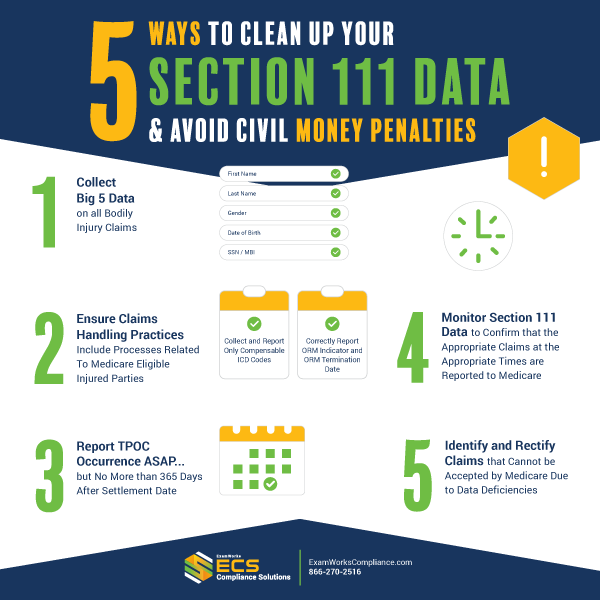It has been a long and winding road since the inception of Section 111 reporting, covering 14 years, more than 35 revisions to the Non-Group Health Plan (NGHP) User Guide and countless Alerts. Fun Fact: The original March 2009 User Guide contained 180 pages, whereas the current version 6.7 contains 578 pages.
The edict back in 2009 of a mandatory $1,000 per day per claim penalty (later softened to a subjective “up to $1,000 per day per claim” via the SMART Act of 2012) terrified the industry into action, but the lack of CMS effectuating those penalties for the past 14 years has led many to a level of complacency - or even apathy. However, during the past 24 months, the Centers for Medicare & Medicaid Services (CMS) published a flurry of Alerts and NGHP User Guide updates. (We discussed these updates in prior blog articles that can be found here: ECS Blog) It’s apparent that this activity has one common thread: CMS has been aligning policy and process in advance of instituting Civil Money Penalties (CMPs). Significant updates of late include:
- “Soft Edits” introduced in Spring 2021 make it easier to get claims accepted by Medicare because errors in certain fields no longer result in outright rejection of a claim.
- ORM Termination Date can be reported upwards of 75 years into the future.
- ORM can be terminated if the following criteria is met: there has been no payment for treatment in 5 years; total medicals paid is less than $25,000; and the injury and treatment does not involve ingestion, exposure or implant.
- The CWF now includes beneficiaries that will become Medicare eligible in the next three months.
- Policy Number is a “Key Field” requiring a Delete and Add submission combination.
- TPOC clarifications surrounding Indemnity vs. Medicals, and proper use of the Funding Delayed Beyond TPOC Date field.
These modifications to technical process absolutely make it easier to get claims accepted by CMS and the policy changes increase the likelihood of a more accurate and usable set of data reported to CMS.
In early 2020, CMS published the proposed CMP structure, but little has occurred since then, perhaps due to the changing political climate and COVID 19, both of which caused CMS to refocus in mid to late 2020. We don’t know exactly when CMPs will take effect, but we do know that an announcement must be made by February 2023. Reviewing the proposed CMP structure, we see three main facets:
- Outright Failure – RREs that fail to register to report, or simply fail to report a settlement, judgment, award, or other payment within one year are subject to the penalty.
- Contradiction – RREs that, when faced with a recovery demand, provide information within the dispute or appeal to contradict information previously reported via Section 111 could be subject to a civil money penalty.
- Poor Quality – RREs that exceed a 20% error threshold in four out of eight consecutive quarters could be subject to a sliding scale of civil money penalties.
Avoiding the above situations involves three tenets we have discussed prior: Accurate, Complete and Timely reporting.
- Accurately report the claim and avoid including unrelated ICD Codes.
- Completely report the claim with the appropriate Ongoing Responsibility for Medicals (ORM) and Total Payment Obligation to the Claimant (TPOC) data.
- Timely report the claim to CMS within 1 year of the TPOC (i.e. settlement, judgement or award).

Knowing that CMS must formally announce the CMP criteria in the next six months, now is the opportune time to get your claims handling and Section 111 Reporting processes in order. Here are some best practices to implement today:
- Collect the Big5 data (first name, last name, gender, date of birth, SSN / MBI) on all bodily injury claims, regardless of injured party age, to determine if the injured party is eligible for Medicare benefits, or document at least three attempts at obtaining the Big5. Remember that age is not the only factor in Medicare eligibility.
- Ensure that your claims handling practices include processes related to those Medicare eligible injured parties. Collect and report only the compensable ICD Codes; correctly report ORM Indicator and ORM Termination Date.
- Report the occurrence of a TPOC as soon as possible, but no more than 365 days after the settlement date.
- Monitor your Section 111 data to confirm the appropriate claims are being reported to Medicare and at the appropriate times.
- Identify and rectify the claims that cannot be accepted by Medicare due to data deficiencies.
The industry has essentially had 14 years to plan and prepare for CMPs, and the clock is officially ticking away. Nobody wants to be the first one hit with CMPs, so if you have any doubts about your Section 111 processes, the time to act is now.
